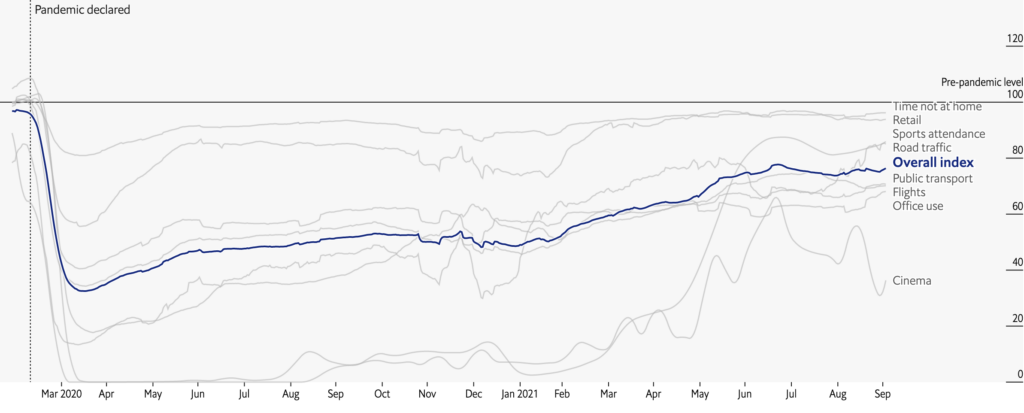Retooling Your Sales Playbook in the Time of COVID

“There is nothing certain but the uncertain.”
PROVERB
Almost two years into the pandemic, as we begin to emerge from the shelter of our homes and back into society, we are gaining an understanding of what it means to live, work and play in the “new normal.” Today, the new normal looks a lot like staffing gaps and disruptions in the supply chain, but it may take a different shape in years to come.
We talk about the new normal as if it’s the next destination along the line. In the first days of the COVID-19 pandemic, we collectively reeled, in what felt like standing in the aisle of a bullet train as it picked up speed, adjusting our weight and doing our best to get our footing. In the early months of 2020, the train accelerated until the landscape in the windows became a blur. We learned the precarious act of doing business on Zoom while our children were at home, experiencing their own train scenario with online learning. We all wondered, and are still wondering, where it will go. Eventually, like being on a train, we began to adapt to the speed, and we started making out the details in the passing landscape – the rhythmic pattern of utility poles and occasional cows dotting the meadows. Almost two years in, more and more, we are learning that the new normal may not be a destination at all, but rather, our ability to adapt to the rapid change.
Mapping normalcy
What we consider normal is completely subjective, of course, but that doesn’t mean that we can’t measure this shared experience that has collectively shifted our behavior and understanding of the world. The Economist has devised the Normalcy Index so we can better understand how things stand, to enable us to make better decisions. The index takes a look at the major sectors in living, work and play across the top fifty GDP economies.

The index is relative to a score of 100, based on measurements at the beginning of the pandemic. The nosedive in March 2020, when governments began imposing restrictions on travel, work and social events, depicts the lowest point, and it has been on a steady rise since. What the graph shows us is some sectors are more impacted over the long run. Understanding where we started may help us understand where we are and where we are going. While we are crawling back toward the notion of normal in some cases, we can also be certain that some things will never go back to the pre-COVID idea of normal.
From disruption to innovation
How does disruption fuel innovation? Let’s start with the issue of supply chains, which have created tidal waves in the global economy that will have impacts for years to come. A good deal of the disruption has been caused by a scarcity of port workers and truck drivers to move our goods from points A to B – that was prevalent even before COVID-19. When COVID hit the manufacturing centers, many factories were essentially shut down. It turns out that despite all of our advances in technology, it took a pandemic to show us that our ability to make and move products is still very limited by one thing: us.
For every cataclysmic event, history has taught us that there is often a silver lining in the form of innovation. After the Great Chicago Fire, the iron and steel industry developed new ways to forge fireproof columns and steel-frame buildings that could withstand much more heat, giving rise to skyscrapers the city is renowned for today. Flu vaccines, penicillin, radar and modern computing were all products of the Great World Wars.
What about economic crises? The executive sales search firm Focus Search Partners examined The Great Recession of 2008 and determined that many lessons learned then are still very relevant today [1]. Those include:
Run lean
Running lean forces businesses to empower people and make decisions faster. It can also involve automating sales processes that are repetitive and having less reliance on humans to foster leads and complete the transaction.
Use data
In the digital landscape, we have data all around us. Examining your sales data allows you to see what tactics are successful and which ones are not. It may also help you see what products your customers are most interested in. Trusting data allows you to remain calm while making informed decisions about your business.
Invest in the business
It is at times of economic downturn when it may make the most sense to invest in your business. It can provide your organization the ability to leapfrog the competition when the economy begins to turn around. Experts suggest that a series of small wins, using data and testing at every turn, rather than delivering on huge projects, is important for future success.
Adapt
Take a look at your products and your service model. Do you provide enough flexibility in your product assortment and sizing or the manner in how you sell it? Consider the pay-as-you-go model of cloud services. This provides a clearer onboarding path and great value for potential customers.
The Great Recession from 2008 forced us to look at ways of innovating and changing how we would do business. COVID has only accelerated the timeline.
The race to digital
Almost two years into this pandemic, we have already seen major shifts in consumer behavior. Analysts are describing a “decades in days” adoption of digital across every aspect of life, from entertainment to healthcare to education.
While the shift to digital was certainly underway before the pandemic, patterns that have emerged speak to an accelerating adoption of digital, and those trends are not likely to reverse anytime soon, if ever.
Digital scorecard
Consider your company’s sales process. Are you enabling your customers with the following digital features?
- Digital sales channel that enables self-service without human intervention
- Electronic product catalog that describes all available products and services
- Ability to communicate to customers when product returns to stock or to provide an alternate suggestion
- Online portal for existing customers to replenish products and engage sales teams
- Ability to capture and leverage online customer behavior and sales data
- Online product knowledge base and support
- Multi-channel customer engagement
- Virtual working and sales process
- Electronic billing and payment system
Businesses that focus on digital solutions to drive delightful, self-service experiences will win the day.
Experience driving sales
Following any major disruption or paradigm shift, it is important to understand the mindset of your customer. If you haven’t talked to your customer recently, this time period presents an ideal opportunity to start the conversation.
Only when you understand the customer can you create user-centric solutions that empower customers and teams that move the needle in sales. Three out of five users think that a positive experience is more influential than strong advertising. Half of potential sales are missed because users are unable to find the information required to make a purchase. When done well, conducting user experience (UX) research returns an ROI as high as 300% [2].
In a previous article, The Role of UX of Marketing, I wrote about conducting customer research to inform human-centered solutions to drive positive experiences and business outcomes. Many businesses skip this step. They believe they have the pulse of their customers and can anticipate their every need. Oftentimes the research reveals that what the business believes are its core competencies or value-benefit statements are different than what the customer believes them to be. It is important for your sales team to identify what motivates your customer to buy from you so you can focus your company’s marketing efforts in those areas, streamlining efforts and advertising budgets. It begins by conducting research about your customer.
Using data from your customer to drive smart business decisions can drive positive experiences and outcomes for the business.
The impetus to change
Before the pandemic, businesses felt that they did not have approval from the customer or the impetus to change. The urge to resist change is something that every business must overcome to remain competitive. Take the following example:
“We were already talking about how we could help our customers do more self-service or self-install but we didn’t feel we had permission or impetus from the customer. “The pandemic came along and suddenly people didn’t want technicians in their house. So it allowed us to accelerate, and that in turn changes how we should think about delivering service and products to the customer.”
RUSSELL OLLIE, VP TRANSFORMATION, AT&T
The pandemic has forced all businesses to look at the way they conduct themselves to serve the needs of the customer. Why not use the pandemic as an excuse to engage your customer?
Creating the digital playbook
Now that you know why you need to retool your playbook, the next step is to create a sales process that leverages technology, increases self-service experiences, creates automation and reduces human intervention.
As customers become more adjusted to the new normal, they will also latch onto the experiences that matter the most and by which every other transaction will be judged.
The train had already left the station before the pandemic. It accelerated, and we are just now accepting that rapid change will be the norm. Businesses that adapt to this rate of change by leveraging digital channels are more likely to meet the customer where they already are.
References
[1] https://focussearchpartners.com/wp-content/uploads/2020/04/Updating-the-Sales-Playbook.pdf
[2] https://medium.com/aleph-universe/roi-and-ux-research-how-can-we-measure-it-295b82b44eea

